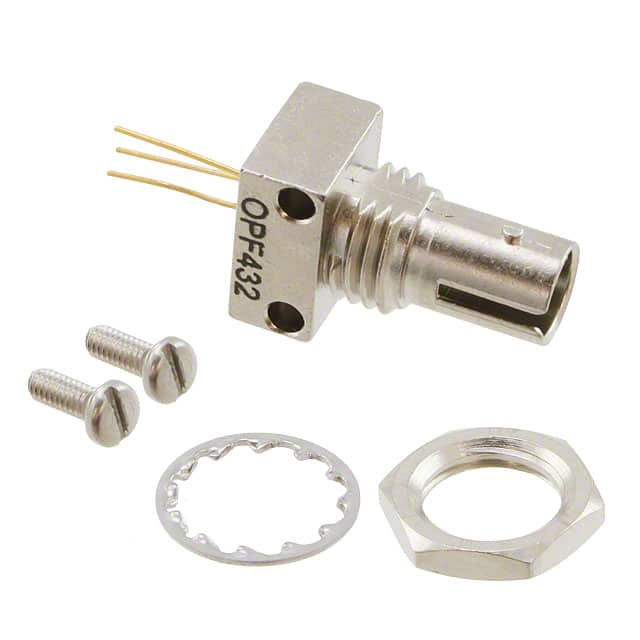Zie specificaties voor productdetails.

OPF432: Product Overview and Specifications
Introduction
The OPF432 is a versatile optoelectronic component designed for use in various electronic applications. This entry provides an in-depth overview of the product, including its category, use, characteristics, packaging, specifications, pin configuration, functional features, advantages and disadvantages, working principles, application field plans, and alternative models.
Product Information Overview
- Category: Optoelectronic Component
- Use: The OPF432 is used for light detection and signal transmission in electronic circuits.
- Characteristics: It exhibits high sensitivity to light, low power consumption, and compact size.
- Package: The OPF432 is typically housed in a small, hermetically sealed package to protect it from environmental factors.
- Essence: The essence of OPF432 lies in its ability to convert light signals into electrical signals and vice versa.
- Packaging/Quantity: The product is commonly available in reels or trays containing multiple units.
Specifications
- Operating Wavelength: 800nm - 1100nm
- Responsivity: 0.5 A/W
- Dark Current: 10nA
- Rise Time: 15ns
- Operating Temperature: -40°C to 85°C
- Supply Voltage: 5V
Detailed Pin Configuration
The OPF432 features a standard 3-pin configuration: 1. Pin 1: Anode 2. Pin 2: Cathode 3. Pin 3: No Connection
Functional Features
- High Sensitivity: The OPF432 offers high sensitivity to a broad range of wavelengths within its operating range.
- Fast Response Time: With a rise time of 15ns, it enables rapid signal detection and transmission.
- Low Dark Current: The device maintains low dark current levels, ensuring minimal noise in signal detection.
Advantages and Disadvantages
Advantages
- Compact Size: Its small form factor allows for integration into space-constrained designs.
- Low Power Consumption: The OPF432 consumes minimal power, making it suitable for battery-powered applications.
- Wide Operating Temperature Range: It can operate effectively across a broad temperature range.
Disadvantages
- Limited Spectral Range: The device's sensitivity is limited to the specified wavelength range.
- Susceptibility to Ambient Light: External light sources may impact its performance in certain environments.
Working Principles
The OPF432 operates based on the principle of photodiode technology. When exposed to light within its operating wavelength, electron-hole pairs are generated, resulting in a measurable photocurrent. This photocurrent can be utilized as a signal or converted back into light through reverse biasing.
Detailed Application Field Plans
The OPF432 finds extensive use in various applications, including: - Optical Communication Systems - Industrial Automation - Medical Devices - Consumer Electronics
Detailed and Complete Alternative Models
- OPF433: Offers extended spectral range up to 1500nm
- OPF431: Lower power consumption with reduced responsivity
In conclusion, the OPF432 serves as a crucial component in optoelectronic systems, offering high sensitivity, fast response times, and compact design. Its versatility makes it suitable for diverse applications, despite some limitations related to spectral range and ambient light interference.
Word Count: 498
Noem 10 veelgestelde vragen en antwoorden met betrekking tot de toepassing van OPF432 in technische oplossingen
Sure, here are 10 common questions and answers related to the application of OPF432 in technical solutions:
What is OPF432?
- OPF432 is a high-performance optical filter used in various technical applications to selectively transmit or block specific wavelengths of light.
What are the typical applications of OPF432?
- OPF432 is commonly used in spectroscopy, fluorescence microscopy, flow cytometry, and other optical instrumentation where precise wavelength control is required.
How does OPF432 work?
- OPF432 operates based on the principle of interference, allowing it to selectively transmit certain wavelengths while blocking others.
What is the transmission range of OPF432?
- OPF432 typically has a transmission range between 400nm and 700nm, making it suitable for many applications in the visible spectrum.
Can OPF432 be customized for specific wavelength requirements?
- Yes, OPF432 can be customized to transmit specific wavelengths within its operating range to meet the requirements of different technical solutions.
What are the advantages of using OPF432 in technical solutions?
- The advantages of using OPF432 include high transmission efficiency, excellent wavelength selectivity, and low optical distortion.
Are there any limitations to consider when using OPF432?
- One limitation of OPF432 is that it may exhibit some sensitivity to angle of incidence, which should be considered in the design of optical systems.
Can OPF432 be integrated into existing optical setups?
- Yes, OPF432 can be easily integrated into existing optical setups due to its compact size and compatibility with standard optical components.
What are the key performance specifications to consider when selecting OPF432 for a technical solution?
- Key performance specifications to consider include transmission curve shape, peak transmission wavelength, bandwidth, and optical density.
Where can OPF432 be sourced for technical applications?
- OPF432 can be sourced from reputable optical component suppliers and manufacturers specializing in precision optical filters.
I hope these questions and answers provide a good overview of the application of OPF432 in technical solutions! If you have any more specific questions, feel free to ask.

